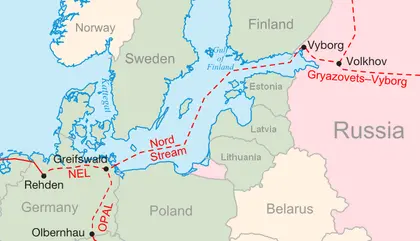The U.S., with the help of Norway, sabotaged the Nord Stream natural gas pipeline between Russia and Germany in a covert operation last September, according to a report by renowned but controversial American investigative journalist Seymour Hersh, published Feb. 8 on his Substack page.
Hersh achieved notoriety as an exposé reporter when he revealed the My Lai massacre during the Vietnam war in 1969, for which he won the Pulitzer prize in 1970. He has since shaken U.S. governments with various investigations, including incidents of U.S. soldiers torturing prisoners in Iraq, and has drawn criticism from peers for shoddy reporting on the killing of Al-Qaeda terrorist Osama bin-Laden.
The White House has categorically denied Hersh’s claim as “false, a complete fiction.” The CIA also responded to the reporter’s request for comment in no uncertain terms: “This claim is completely and utterly false.”
The original pipeline, Nord Stream 1, went into service in 2011. A second pipeline, Nord Stream 2, had just been completed in 2022, before Russia’s full-scale invasion of Ukraine. Combined, the two pipelines would provide Germany with more than half of their gas needs. Nord Stream AG, the holding company that runs the pipeline is 51-percent controlled by Russia’s state-controlled Gazprom, the rest by four European energy companies.
The pipeline has been a source of controversy since its inception. The Trump administration had imposed sanctions on companies working to build Nord Stream 2, and the Biden Administration reluctantly removed those sanction in 2021.

Team Biden Resorts to ‘Not My Fault’
On Sept. 26, 2022, multiple ruptures in both Nord Stream 1 and Nord Stream 2 pipelines were detected, with methane gas bubbling up to the surface of the Baltic Sea. Subsequent investigations by Swedish authorities determined sabotage to be the most likely cause.
Hersh’s investigation came to the conclusion that the U.S. Navy’s Diving and Salvage Center in Florida had elaborated a plan that would use the annual NATO Baltic Sea exercises, (BALOPS 22) as cover to plant explosive devices on the pipeline. The ideal location for the detonation was in the relatively shallow waters, less susceptible to currents, off the coast of the Danish Island of Bornholm.
Planners chose the obscure diving center for a “vital bureaucratic reason,” Hersh’s lone unnamed source with direct knowledge of the operational process said. The Biden Administration was doing everything possible to avoid leaks as the planning took place late in 2021 and into the first months of 2022. Since the divers were Navy only, and not members of U.S. Special Operations Command, whose covert operations must be reported to Congress and briefed in advance to the Senate and House leadership, it would be easier to maintain the necessary level of secrecy.
How Hersh says it was done
The details of Hersh’s report read like the treatment for an action thriller. The original plan was supposedly to blow up the pipeline within days of concluding the BALOPS 22 exercises. The explosive charges, placed by specially trained divers, would be detonated by remote control. At the last minute, Biden wanted the possibility of setting off the charges at a much later date. The extended time frame risked having the charges detonated inadvertently by underwater activity.
Roughly two months after the charges were first placed on the pipeline, according to Hersh’s reconstruction, Biden gave the green light to blow up the pipeline.
On Sept. 26, a Norwegian Navy P8 surveillance plane made a seemingly routine flight and dropped a sonar buoy. The buoy would emit a sequence of unique low frequency tonal sounds that would be recognized by a timing device and, after a pre-set hours of delay, trigger the explosives. The signal spread underwater, initially to Nord Stream 2 and then on to Nord Stream 1.
Many analysts had suspected Biden of being behind the sabotage after watching video of a Feb. 7 press conference at the White House with German Chancellor Olaf Scholtz. Standing beside Scholtz, less than a month before Russian tanks rolled into Ukraine, Biden fielded a question from a Reuters reporter asking what the president intended to do about Nord Stream in the event of a Russian invasion. Biden’s response was striking for its terse delivery: “If Russia invades… there will be no longer a Nord Stream 2. We will bring an end to it.”
As Hersh’s lone source in the report put it: “Well, I gotta admit, the guy has a pair of balls. He said he was going to do it, and he did.”
Cui bono?
While it must be emphasized that Hersh’s account is based entirely on a single unnamed source – which does not meet basic journalistic standards and perhaps accounted for the fact that he didn’t publish it in any major newspaper – the report’s plausibility is hard to overlook. This is especially true when considering who is to gain. If Germany is forced to look for other sources of natural gas, then two of the largest exporters of natural gas ready to fill the shortfall are Norway and the U.S.
Indeed, in 2022 Norway provided 33 percent of Germany’s natural gas needs, replacing Russia as the largest supplier of gas to Germany. The previous year, imports from Norway accounted for just under 20 percent of Germany’s supply.
In January of this year, the first U.S. tanker carrying liquified natural gas (LNG) arrived in Germany. U.S.-produced LNG, which is more expensive than the gas Germany had been receiving from Russia, will now make up an increasing portion of Germany’s energy mix.
Pipelines as spying platforms
Apart from economic incentives to bringing an end to gas flowing from Russia, there is also a tactical consideration. Pipelines nowadays are often used to spy on other countries, and Russian has long been at the forefront of such activities.
Andrii Ryzhenko, a former officer in the Ukrainian Navy and a graduate of the U.S. Naval War College, has written extensively on the efforts of the Main Directorate of Deep Sea Research (GUGI), a highly secret Russian military unit, and Moscow’s pursuit of Russian national interests in the underwater domain, particularly in surveillance of NATOs communications cables.
For security reasons, gas pipelines have specially designated sonars which ensure safety in the vicinity. “However, it is very easy and comparatively inexpensive to connect aside lines composed of a number of sonars for military purposes,” he writes.
“Using facts of the shallow depths of the Baltic Sea and the short distances from the Nord Stream to the coasts of neighboring countries and to the critically important Åland Islands, Gotland and Bornholm, Russia can deploy a passive underwater surveillance system in a relatively short period of time at the base of several lines.”
These factors, combined with Washington’s overriding concern over Germany’s reluctance to join in hardline sanctions against Russia and vigorously support Ukraine, would presumably account for Biden’s decision to sabotage the pipeline, if Hersh’s report is to be believed.
You can also highlight the text and press Ctrl + Enter






